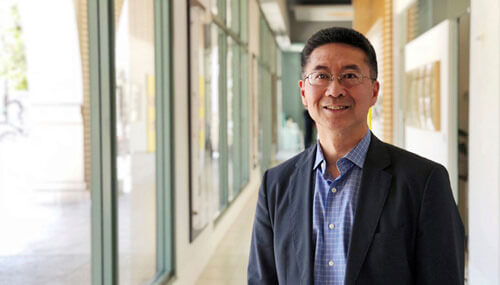U.S.-Asia Business
Business Opportunities in the New Age of Medicine
By

How a bioscience company is capitalizing on new medtech to expand globally and save lives.
The decision to start Sofie Biosciences and revolutionize the way patients are diagnosed and treated for diseases was a personal one for Philipp Czernin and Melissa Moore. Both of Czernin’s grandparents were diagnosed with cancer, and his mother was diagnosed with Stage 3 metastatic breast cancer three years ago; for Moore, it was her father and kidney cancer.
For both of them, the scariest part wasn’t the diagnosis—it was the unknowing. “Not having that piece of information about what’s going on with you is the scariest part for the patient, for families,” says Moore. “Here, we are able to provide this piece of information, especially to our loved ones.” That’s what prompted the two of them to start a company that would help bridge the gap between diagnosis and treatment.
“Traditionally, they [the doctors] come up with a treatment plan, and they have no idea whether the proposed treatment is going to work or not,” explains Czernin. “They give these people chemotherapy treatments that work, on average, really well on about 15 percent of the population. If you’re the unlucky 85 percent that are non-respondents, then you’re getting all the side effects and complications associated with traditional chemotherapy treatments, with none of the upsides.”
Find your niche in the medical industry
Sofie’s mission is to essentially refocus the way people think about healthcare, from treatment to a more integrated diagnostic/therapy approach known as “theranostics” (a combination of “diagnostic” and “therapeutics”) by utilizing PET’s (positron emission tomography) greater accuracy and efficiency for preclinical and clinical uses. The company currently develops three different kinds of PET imaging instruments for pre-clinical research, as well as a radiochemical synthesizer called ELIXYS that allows both researchers and clinicians to develop their own radioactive compound for any specific purpose they want.
Unlike CT (computed tomography) scans, which use X-rays, PET scans use radioactive tracers to reveal “metabolic changes in an organ or tissue” at the cellular level, which is important because diseases often start with changes in the cells. The patient is usually injected with a small amount of radioactive drug, most commonly fluorodeoxyglucose (FDG), which then gets absorbed into the organs and tissue, and allows clinicians to see exactly how well they are working. Clinicians will know much sooner what is wrong with the patient and subsequently determine the best treatment available, instead of having to rely on the usual try-and-fail method.

“We really think there is a new niche and a new life for nuclear medicine, and we want to play a prominent role in that.”
“Therapy always takes the spotlight,” says Moore. “Even from a clinical trial perspective, the idea that you might have something cured or put in remission—that’s really exciting. The diagnostic piece has sort of been overlooked, which provides you the information to give you the best chance at therapeutics. If you’re giving people more diagnostic capabilities, then you’re creating for them the toolkit for informative therapeutics.”
Dr. Johannes Czernin, one of Sofie’s founders and Philipp’s father, says that this focus on the emerging field of theranostics is what gives the company its competitive edge. “Some [companies] focus predominantly or exclusively on research applications; others focus on clinical applications, but don’t utilize the entire power of technology advances in preclinical and clinical sciences,” he explains. “I think that one of our strengths is that we see it really comprehensively, from basic science, to meaningful clinical applications.”
However, part of the reason PET imaging is underutilized is because of its cost. Whereas a regular CT scan can range from $1,200-3,200, a single PET scan can cost anywhere from $3,000-6,000. For a clinician to even acquire a PET scanner, he or she would currently have to pay around $5 million, says Czernin. Luckily for Sofie, that gives them an opportunity to develop a low-cost PET imaging tool that would make their technology much more widely available.
“We want to do devices that are more on the order of several hundred thousand dollars, as opposed to several million, so a clinician can always have a PET scanner in a small clinic,” states Czernin.
Expanding through strategic partners and acquisitions
In order to get the prices down and make PET more widely available to everyone, Czernin says that they have to “attack every step along the supply chain,” from building their own devices, to developing the right network to distribute their products. Sofie must be strategic about what companies to acquire and/or partner with in order to get to that level.
Sofie’s relatively small size allows them to form long-term partnerships with smaller, more innovative companies because they aren’t bogged down by bureaucracy, like some of their larger competitors. “[We’re] willing to try something new, be disruptive, get out with a new clinical product or a new clinical trial, and shoot for the moon,” Moore says. “That’s how we align ourselves. We can do something for a year or a Phase 1 clinical trial—if it doesn’t make it, we still learned some really valuable information that [those companies] get to put back into their pipeline and bring forth a new product.”
In 2017, Sofie Biosciences acquired their first company, Zevacor Pharma, a leading developer, manufacturer, and distributor of PET radiopharmaceutical products and services. Although they weren’t looking at Zevacor specifically, Sofie was in the market for a company with a solid radiopharmacy (the manufacturing and supply of radiopharmaceuticals) network and jumped at the chance to expand their business.
Finding the right financing
In order to acquire Zevacor, Sofie founders knew that they needed more than venture capital. “Zevacor sort of fell into our laps,” says Czernin. “It was completely unexpected—serendipitous, you could say. With that being said, we found the opportunity and knew that we were going to need to find access not just to venture capital, but that we were going to need to debt-finance a portion of the deal as well.”
Sofie had trouble finding a bank that would give them the time of day, let alone a loan, since the amount they were looking for was comparatively small. “We talked to all the conventional players that VCs would tell you to go talk to, all the banks that come to mind, but none of them gave us any time,” says Czernin. Luckily, Czernin met Johnny Lee, managing director and chief administrative officer of U.S.-Greater China bridge banking at East West Bank, and recognized that a partnership would be strategic for both. “Not only did they help us finance a portion of the deal that we couldn’t finance ourselves, but I also see Johnny and East West Bank as partners as we figure out how to take the next leap into China,” he adds.

“China is already the second-largest medical device and pharma market in the world.”
With a term loan and revolving line of credit, Sofie was able to acquire Zevacor and its 16 radiopharmacy sites across the United States, as well as set the groundwork for expansion into emerging markets such as China. Lee says that China’s aging population and increasing need for improved healthcare, particularly for cancer treatments, makes it an ideal target market for Sofie Biosciences.
“China is already the second-largest medical device and pharma market in the world, and with its continuing focus on improving its healthcare during the next few years, Sofie is exploring potential business opportunities to expand into the China market,” says Lee. “With East West Bank’s network in Greater China, we can help them navigate through the system in China and are pleased with this partnership.”
Czernin and Moore know that, in order to successfully enter a market like China’s, they need the right strategic partners. “We are currently evaluating joint venture opportunities,” says Czernin. “I think that the prospective partners that we’ve talked to like the idea of having a U.S.-based partner with some expertise as a de-risking mechanism. We understand that in a market like China, there’s a strong need to have a local partner—and local expertise and connections, as well. We have no illusions about going into China without a really well-qualified, well-vetted local partner.”
Preparing the path to IPO
Finding the right partners and investors is also important for Sofie to achieve its goal of going public. Developing the technologies and medications to cure cancer or neurological diseases requires massive amounts of capital, more than any bank loan or venture fund could provide. “Ultimately, to get the kind of compounds and medications that we’re interested in, we have to have access to the capital that you can only find in the public markets,” explains Czernin. However, in order to get to IPO, Czernin and Moore need to continue licensing theranostics technology to develop their own products and, eventually, their own network of theranostics centers. In order to get to that point, they need to find investors that are in it for the long haul.
Czernin and Moore vet their investors very carefully before they bring them on board, in order to maintain control over their company’s destiny, as well as to make sure they have secure long-term capital. For Sofie, investors have to be “ideological believers” in the company’s mission and have a clear view of the company’s trajectory. “This is a long play,” Czernin emphasizes. “Developing drugs, whether diagnostic or therapeutic, takes a lot of time and money—there is no instant gratification. It’s taken a tremendous amount of passion and commitment just to get the company to this point.”
He adds bluntly: “The time is now. We really think there is a new niche and a new life for nuclear medicine, and we want to play a prominent role in that. We’re going to go raise some more money, we’re going to license some theranostic compounds, and we’re going to attack this market head-on.”

